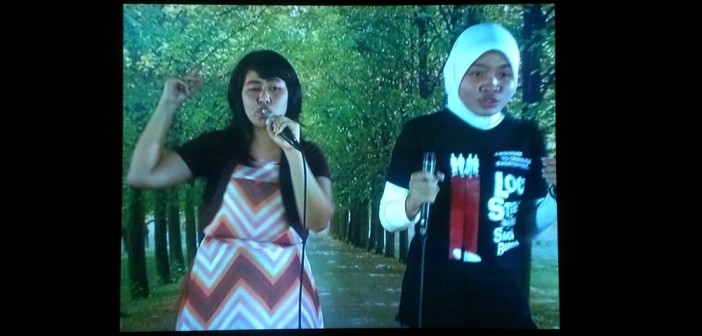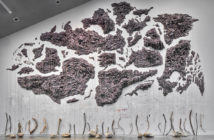I've been listening to The Smiths' The World Won't Listen on and off for over a month solely because of Phil Collins and Wellesley College. It's a bit too emo for my tastes today, but I don't remember thinking that when I was younger and more morose. Of course, I have no memory of listening to Ragnar Kjartansson’s music when I was younger because he's the same age as me and wasn't a child pop music prodigy. It's probably better that I can't nail down Kjartansson's music to an earlier era of my life, as it lets me see the work for what it is today; unlike The Smiths.
The video, film, moving image, projected time based visual media; no matter what you call it there is no doubt that it is here to stay in the art world. There is a diversity of practice today that wasn't present when video art was really on video cassettes. While there are certainly differences between Nam June Paik's explorations of live broadcast and William Wegman's Dog Duet—one huge difference was that one cared about the global village, while the other shot mostly self-portraits, of a kind, in his studio—both artists' work rely on our awareness of time and the reality of the event. Even Bill Viola's work couldn't escape this obsession with the awareness of nowness.
Today, there are certainly artists whose work resembles other artists, but I'd argue that there is diversity in video practice today that we should celebrate. The Otolith Group is not Christian Marclay and neither is Richard Phillips, thank god.
One way Kjartansson's work stands out from the congregation of video artists is that many of his compositions are deeply formal. His multi-channel compositions just wouldn't be the same if they were presented on your phone in one channel. Being immersed in the jam band mood of The End, being able to discover which channel holds each sound, being able to learn the core of the song by recombining each channel into a compositional whole, being able to consider the absurdity of bringing a piano into a remote snow field; all of these elements give The End a joyful presence and each is grounded in the corporeal reality of the video. On a more cerebral level, The End is less simple. It's an interesting enough song played by a duo that intends, like most of Kjartansson's work, to build up the various formal elements into a new legend; similar to the Icelandic sagas that he regularly references when clarifying his work's intent.
Phil Collins' Dunia Tak Akan Mendengar (The World Won't Listen) tacks a different course. His video relies on the political climate in which recorded music is drowning itself. The commercialization of lifestyle, that seems everyone tried to sell everyone else during the nineties, is most persuasive if you consider buying into a band's lifestyle a requirement of being a fan. It's part of the reason why there are seemingly endless subgenres in music, and the Grammy's have to make up new award categories every few years. Here, Collins takes the readymade album The World Won't Listen (a compilation from 1987 of singles and B-sides) and presents it by filming fans singing the album karaoke style. This project was filmed in three different countries, Turkey, Colombia, and Indonesia.
The reason that Collins filmed in countries spread around the world is to show how music is the last form of colonization available to the mighty English Empire. The Smiths have affected the youth culture of the entire world; the sun does not set on The Smiths. Even their B-sides, presumably their minor works, have become anthems that the entire world knows. Beyond knowing these songs, they are a foundational pillar for a ageless counter culture; an alternative that thirty plus years later still leads to emotions that are neither original nor new from fans that were born after the album was complied; but these emotions are true and immediate anyway.
Becoming lost in Kjartansson's work at the ICA or Collins at Wellesley is easy. Between the power of music and the museum scale presentation, you end up immersed in the work. Excluding the three-channel work of his mother spitting in his face, that is. Besides being gross. It seems very out of place with these other videos.
In 2005’s Satan is Real, Kjartansson is buried up to his hips in the landscape while playing a simple blues song on his guitar repeating the lyrics over and over again, even though they are not the original lyrics but instead what he thought they were. This video, while not very complicated and certainly less immersive than his multi-channel videos, still, it might build up into a new saga. I can’t escape being reminded of Dante’s Satan, buried in the ninth ring of hell (a word borrowed from Icelandic) up to his hips in Ice. Constantly needing to feed on whatever he can reach around him (which happens to be Judas, Brutus, and Cassius), Dante’s Satan is profligate, ravenous, and isolated. He needs ever more stimulus but will never receive it. Maybe Kjartansson is that creature, needing more, but buried up to his hips in a land that is more authentically his own than the American blues songs that he misquotes. Needing more songs to sing, trying to squeeze more from his existence than is native to Iceland, ultimately he creates a new story for himself and his country.
Collins and Kjartansson’s videos are in very different theoretical spaces. Where Collins is reflecting on the absurdity of the music with which he grew up being universal and freely available to the entire globe, Kjartansson is trying to live in the now by reaching back in time to assimilate a foreign born song into his own era and culture. Both rely on that old Marxist plot device: Capitalism forces the unavoidable spread of cultural products. But the music is the core of what makes these artworks so engrossing and discussing the politics bogs down that immediate, haptic experience of being in the room with these works.
I’m not sure that both hold the same political leaning, but it’s an unavoidable concern as they are both based on cultures absorbing foreign-born music. But more than the otherness of the music, there is also the temporal concern. As the hip hop that I grew up listening to ages with me and the jazz that predates my birth by more than 20 years just keeps getting older too, I’ve had to come to terms with the fact that I listen to the oldies. I’m no different than the people who I grew up with that listened to Woodstock era music in the 90’s. I’m a throwback. Do either of these artists think that they are throwbacks? They must be aware that they are clearly evoking a previous world that doesn’t exist any longer? It’s easy to smell the glue with which they are collaging together different eras.
I’m not sure I care about those issues as much as I’m seduced by the music in these two videos. I just want to get lost in the music. But that might be part of the problem.
- Phil Collins, Dunia Tak Akan Mendengar (The World Won’t Listen), 2007
- Phil Collins, Dunia Tak Akan Mendengar (The World Won’t Listen), 2007
- Ragnar Kjartansson, Satan Is Real, 2005. Single-channel video (still). Performance. Museum Dhant-Dhaenens, Ghent, Belgium. 2004. Courtesy of the artist, Luhring Augustine, New York and i8 Gallery, Reykjavik.
- Ragnar Kjartansson, The End, 2009, five-channel video (still) Courtesy of the artist, Luhring Augustine, New York and i8 Gallery, Reykjavik
Ragnar Kjartansson: Song is on view at the ICA, Boston through April 7, 2013. His newest multi-channel video, The Visitors, is on view at Luhring Augustine through March 16.
Phil Collins' Dunia Tak Akan Mendengar (The World Won't Listen) was part of Provisional Aesthetics, Rehearsing History at The Davis Museum at Wellesley College. It was exhibited from October 17, 2012 through January 11, 2013.








